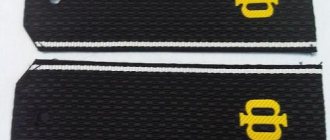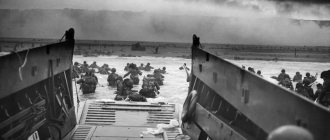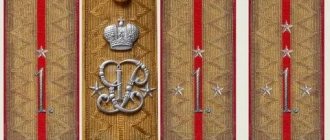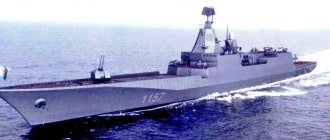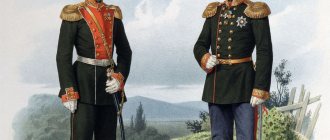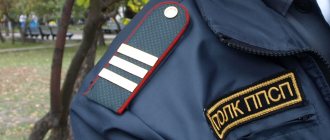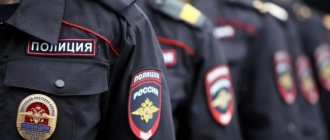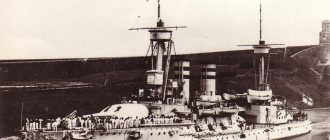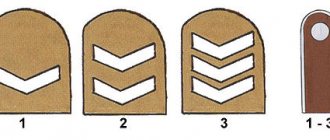The Russian Marine Corps has existed for more than 300 years. The first mention of such units dates back to the Northern War in 1705. Until 1917, they were called naval soldiers. To date, it is still an important part of the army, having its own distinctive signs and anthem.
Origin of Russian guy
Guys appeared in the Russian Empire in 1658 - after Peter the Great visited the Kingdom of England during the Great Embassy. The flag was supposed to symbolize the power and greatness of the young Russian fleet, which is why its appearance was chosen in the likeness of the flag of the most powerful maritime union - Britain and Scotland, which we examined in detail above.
On the Russian guis, in contrast to the symbol of union, the cross of St. Andrew the First-Called dominated over the cross of St. George, and not vice versa. This was done because it was from Saint Andrew, according to Peter, that Rus' received baptism. This cross also had a symbolic meaning - at the time of the creation of the guis, the state already had access to four seas. That is why the first Russian Order of St. Andrew the First-Called was approved in the form of the same four-sided oblique cross.
The use of this nasal flag, which became the prototype of the modern flag of the Russian Navy, began in 1701. His image was also used as a serf standard for forts and other coastal sites.
Historical reference
The current banner of the Marine Corps was formed on May 7, 1992 after the abolition of the USSR Marine Corps. The first banner has existed since the Middle Ages. True, we are not talking about the banner itself, but about the St. Andrew's Cross, one of the ancient heraldic symbols often used in military heraldry. The old infantry banner itself was not officially approved, but was chosen on July 21, 1992. This alarmed both ordinary soldiers and representatives of the Ministry of Education.
Recently, this deficiency led to the official change of the military heraldic symbol. The new flag was approved on December 27, 2020. It is noteworthy that the change caused a mixed reaction, amounting to indignation. Experienced warriors did not understand why the Minister of Defense abandoned the St. Andrew's Cross, because this symbol represented the Russian navy for several centuries.
To which the Ministry responded that all previous banners were not official, and a replacement in 2022 was supposed to solve this problem. The answer is very vague, which is why the conflict was not resolved.
Marine Corps Missions
The tasks of the Marine Corps include:
- capturing the landing area, creating and holding landing bridgeheads, defending the landing base;
- capturing important coastal positions and objects, holding positions until the main forces arrive;
- capture of ports and locations of enemy naval units;
- destruction of elements of control systems and high-precision enemy weapons located in a coastal zone or island, air and missile defense facilities, coastal airfields and other enemy objects.
The Ka-27PS helicopter carries out a marine landing on the enemy coast
A little history
The first unit of the Navy was intended to carry out rapid strikes from the sea during the war with Sweden. Initially, it was a relatively small unit, consisting of 1,200 experienced warriors. Since the experience gave good results, the unit was expanded, and taking into account the specifics of combat, it was divided into several battalions.
Before the development of Siberia and access to the shores of the Pacific Ocean, there were two large marine corps units on the territory of the Russian Empire: in the Black and Baltic Seas. For several centuries they took an active part in battles with Turkey, Sweden and other countries at sea.
During the Patriotic War of 1812, the marine was deployed on land. So, he took part in the famous Battle of Borodino. Later, it was these units that were responsible for the defense of Sevastopol, Moscow, Leningrad and other cities during the Crimean, Russian-Japanese and Great Patriotic Wars. The spirit of the soldiers who fought in these ranks was reinforced by the motto of the Marine Corps: where we are, there is victory.
Over time, this military unit has undergone reorganization more than once, and sometimes almost completely eliminated. Thus, during the 19th century, the previously created battalions no longer existed, since the government did not see the point in their existence. For the first time during the reorganization of naval soldiers, it was planned in 1916-1917, but the outbreak of the revolution did not allow these plans to come true.
The Soviet Marine Corps began to exist in 1940. During the Great Patriotic War, such brigades were created on all maritime borders of the USSR. In those years they received the famous nickname “black death” or “striped death”.
Decades after the war, the troops underwent reorganization again. In those years, they not only guarded objects of state significance, but also took part in battles during two Chechen wars.
After the collapse of the USSR, most of the Navy remained under the control of the Russian Federation. The exception was the Black Sea Fleet, which had to be shared with Ukraine for several years.
Marine Corps in Chechnya
Marine units during the Chechen campaigns, thanks to their fearless actions, earned honor and recognition among the entire military community.
The Chechen war became a great test for young Russian soldiers. The Chechen fighters had significant combat training, knew the terrain very well, and had many informants among the local population.
Therefore, fighters with special professional combat training were urgently needed. Throughout the Chechen conflicts, Russian marines did not give up their positions, did not give up even in the event of mortal danger. The fallen soldiers remained forever in the memory of their relatives and fellow soldiers.
Marine reconnaissance officers are improving their mountain training to participate in combat operations in the mountains
In the most difficult combat situations, Marines found themselves at the center of events. When in 1995 in Grozny, terrorists turned the city into an impregnable fortress and battles were fought for every block, for every entrance, the Marines also showed their steadfastness and courage, and it was the Marines who hoisted the St. Andrew’s flag on the palace. The remaining film footage from that assault shows those terrible events and the participation of the Marines in them.
Correspondence between naval and military ranks
Military and naval ranks correspond as follows:
| Marshal of the Russian Federation | |
| Fleet Admiral | Army General |
| Admirals | Colonel Generals |
| Vice Admirals | Major Generals |
| Rear admirals | Lieutenant Generals |
| Captains 1st rank | Colonels |
| Captains 2nd rank | Lieutenant Colonels |
| Captains 3rd rank | Majors |
| Captain-lieutenants | Captains |
| Lieutenants | |
| Junior lieutenants | |
| Senior midshipmen | Senior warrant officers |
| Midshipmen | Ensigns |
| Chief Petty Officers of the ship | Petty Officers |
| Petty Officers 1 article | Sergeants |
| Petty Officers 2 articles | Junior Sergeants |
| Senior sailors | Corporals |
| Sailors | Privates |
Naval ranks and insignia on shoulder straps in the Russian army are clearly structured, so they are quite easy to understand even with a superficial acquaintance.
What colors and types of uniforms are used in the navy?
Sailors are, first and foremost, military personnel. Therefore, as in other branches of the military, they have a clear hierarchy. Depending on the position, the naval suit varies.
Thus, the sailor's uniform, as well as the clothing of the cadets, consists of a white shirt, trousers, collar, shoes and headdress. The entire suit is made in blue. The collar is decorated with white stripes.
@gunsfriend.ru
The clothing of officers and midshipmen includes the following elements:
- wool cap;
- uniform jacket;
- coat;
- cream shirt and tie;
- trousers with belt;
- shoes;
- scarf and gloves.
@chvvmu.mil.ru
All clothes, except the shirt, are made in a laconic black tone. Moreover, officers are allowed to wear a sweater, jacket, cap and jacket.
Girls in the navy wear a woolen skirt, a cream-colored blouse, a jacket, a gold-studded tie and shoes. The sailors' uniform is predominantly black. Even on the hottest day, girls are required to wear nude tights. In winter, the uniform set is complemented by a woolen coat and muffler. You are also allowed to wear a hat with earflaps and a sweater.
Ceremonial sets
There are several of them too.
The fundamental difference is the color. Black and white are the two colors allowed in the Navy. A gold-studded tie is required. The basis of any dress uniform is black trousers, a white shirt and a gold belt.
The petty officer and sailors wear a traditional striped vest. The headdress is a capless cap in summer and a hat with earflaps in winter.
The women's version of the "paradka" also almost completely imitates the everyday one. The only difference is that the festive costume is equipped with a gold belt. The jacket and scarf are white.
@aleksey-pelevin.blogspot.com
The white dress uniform of sailors looks very beautiful and solemn. But unfortunately, they may not demonstrate it as often as they would like!
Junior naval ranks and insignia
Petty officers have insignia - stripes, yellow fabric braids (for both everyday and festive uniforms). Naval ranks:
- foreman of the second article (2 galloons);
- foreman of the first article (3 braids);
- chief petty officer (one wide stripe);
- chief ship's foreman (one wide, longitudinal braid).
Midshipmen's shoulder straps are somewhat similar to those of officers, but are made without gaps (vertical sewn stripes); edgings can be added. The insignia is small vertical stars. Naval ranks:
- midshipman (two stars);
- senior midshipman (three stars).
- Insignia of military personnel of the Navy.
- 1941-1945.
By the beginning of the war, Navy personnel wore insignia established at the end of 1935 with additions and changes adopted in 1937, 1939 and 1940. Navy personnel wore insignia on their sleeves in the form of galloon stripes, over which a star was sewn; the senior Red Navy man - only a red star with a gold edge, and the Red Navy man - a red star.
We invite you to familiarize yourself with Removal from military registration for health reasons
In addition to insignia, specialists of junior command and rank and file also had insignia for their specialties, which were sewn on the left sleeve of an overcoat, pea coat and flannel shirt. Long-term servicemen of the Navy wore gold chevrons on their left sleeves, point downwards: for 5 years of long-term service and above - 1 chevron, for 10 years and above - 2 chevrons, for 15 years and above - 3 chevrons.
In June 1942, the People's Commissar of the Navy established a special guards ribbon for caps for enlisted personnel awarded the rank of guards. Since October 1942, in connection with the introduction of unity of command and the abolition of the institution of military commissars in the Soviet Army and Navy, military ranks and insignia common to all commanders of the Soviet Army and Navy were established for deputy commanders for political affairs and for all other political workers.
In November 1942, a gilded metal edging in the form of a convex image of oak leaves on the visor of a cap (ornament) was introduced for senior command and engineering personnel of the naval service. By Decrees of the Presidium of the USSR Armed Forces of February 15, 1943, new insignia were established for Navy personnel - shoulder straps.
Navy servicemen who were assigned the general army uniform were given the same shoulder straps as for the corresponding units of the Soviet Army. In October 1943, rank insignia - shoulder straps and shoulder straps - were introduced for students of the Nakhimov Military School. Pupils from the 6th grade wore sleeve insignia for their grades - squares made of red cloth.
The insignia of military personnel also included piping, stripes, emblems, cockades and stars on headdresses, sewing on uniforms and headdresses.
| Insignia of the Navy. 1941-1945. | ||
| Sleeve insignia and shoulder straps. | ||
| 1941 - 1942 | 1943 - 1945 | |
| Dress: | Front door | Patches |
| Rank: Sailor | ||
| Rank: Senior Sailor | ||
| Fleet: | Pacific | |
| Rank: Petty Officer 2nd class | ||
| Fleet: | Black Sea | |
| Rank: Petty Officer 1st class | ||
| Fleet: | Northern | |
| Fleet: | Baltic | |
| Rank: Midshipman | ||
| Rank: Junior Lieutenant | ||
| Rank: Lieutenant | ||
| Rank: Senior Lieutenant | ||
| Military lawyer | ||
| Rank: Lieutenant Captain | ||
| Military doctor 3rd rank | ||
| Rank: Captain 3rd rank | ||
| coastal defense | naval service engineer | |
| Rank: Captain 2nd rank | ||
| Navy aviation | ||
| Rank: Captain 1st Rank | ||
| naval service engineer | ||
| Rank: Rear Admiral | ||
| Divisional Commissioner | naval service engineer | |
| Rank: Vice Admiral | ||
| Rank: Admiral | ||
| Rank: Fleet Admiral | ||
| Rank: Chief Admiral of the Fleet | ||
| This order did not exist until 1943. | ||
| Rank: Admiral of the Soviet Union | ||
| This order did not exist until 1943. |
| Sleeve stripes of long-term service sailors | Capless cap |
| Petty Officer 2nd Article | Each strip is 5 years of long-term service. | Guards ribbon for cap. |
| Sailors' sleeve chevrons |
Navy sailors' badges
| Badge "Excellence in the Navy" | Badge "For combat trawling" | Badge "Excellent Submariner" | Badge "Excellent torpedoist" |
| Attributes of the command staff of the Navy | ||
| Badge "Submarine Commander" | Naval officer's dagger. | Admiral's cap. |
| Navy enlisted uniform |
| Navy Command Uniform |
The Marines unexpectedly changed their flag and emblem, all that remained was to remove the motto “Where we are, there is victory!”
Can't you remove the words from the song?
Well, don't tell me. Just recently, the anthem of the Russian Marine Corps sounded: “The infantry is marching, and its step is firm. And St. Andrew’s flag flies over us.” It is immediately clear that this is not the “queen of the fields” singing - the infantry of the Ground Forces, not the winged infantry of the Airborne Forces, but the Marines, who are tightly connected with the Navy. Now, quite unexpectedly for many, the Ministry of Defense has approved a new flag and emblem of the Marine Corps, which are now noticeably different from the previous symbols. The most important thing is that St. Andrew’s flag with crossed blue stripes was replaced with black and red ones. In the manner of the St. George's Cross. To an uninitiated person, such transformations are by and large violet. Well, they came up with a new flag for the Marines, so what? They say that the Ministry of Defense simply standardized and brought to uniformity all the flags of the branches, branches and services, and the flag of the Marine Corps also fell under them. In the army, the main thing is that it is not ugly, but monotonous, that there is no “Makhnovism” and crimson riding breeches. Now, according to the Ministry of Defense, the basis of the modern flag is not the St. Andrew’s flag, but the St. George flag - also a white cloth with a cross of black stripes with three red stripes - two on the sides and one in the middle. It is argued that these colors symbolize the exclusive affiliation of the Marine Corps with the navy, which wears a black uniform, and at the same time with the “ground forces” with gaps on their shoulder straps in red. By the way, naval officers wear them yellow.
Only the anchor on the flag and emblem has been preserved in the symbols of the Marine Corps - as a symbol of these soldiers’ belonging to both the sea and the land, a kind of connecting link between water and land, where they feel equally confident. True, the anchor in the center of the flag remained without its usual frame, and against its background a new symbol appeared - the grenade (grenade) from the 18th century, which was armed with grenadiers, who, by the way, had no affiliation with the fleet.
If we talk about the history of this type of troops, then in Russia it began in the second half of the 17th century, when teams of “sea archers” appeared among the crews of the ships of the flotilla created by the decree of Ivan the Terrible. From the well-known - in 1669, the first Russian military sailing ship "Eagle" had a similar crew of 35 people intended for boarding operations and guard duty. Already during the Azov campaigns, the Naval Regiment was created, which recruited the most capable soldiers and officers of the Preobrazhensky and Semenovsky regiments. On November 16, 1705 (November 27, new style), Tsar Peter I (he became Emperor of All Russia in 1721) issued a decree on the formation of a naval regiment. This day became the birthday of the Russian Marine Corps. Already in the current Russian Federation, the official Day of the Marine Corps was established by order of the Commander-in-Chief of the Navy in 1995.
The Marine Corps, “sea soldiers,” were noted for their valor and bravery in the battles of Sinop Bay, Gangut and Chesme (they are symbolized by three stripes on a sailor’s guy), during the assault on Izmail and Corfu, and in the defense of Port Arthur and Sevastopol. During the Great Patriotic War, the marines, and these were mostly sailors removed from ships, terrified the Germans and their allies - they went into the attack in vests and caps, the ribbons of which they bit with their teeth. Their enemies called them the “Black Death.” The modern service of the Marines is also imbued with valor; here we can recall the participation of the 61st separate Kirkenes Marine Brigade in the Chechen Wars. St. Andrew's flag with an anchor in the center proudly flew over both Grozny and the Argun Gorge.
The very combination of the two words “marine” and “infantry” introduced special conditions for the service of this type of troops, including the flag, symbols, uniforms and even military ranks. And if for the Marines a private is a sailor, then a sergeant is not a petty officer of the first class, but a sergeant, there is the rank of midshipman, but for officers the ranks correspond to the army ones, without any captain-lieutenants and captains of the 1st rank. In uniform, they are similar to the navy in the naval vest and giys in full dress uniform; the officers also had naval tunics, but the main difference is that the beret is black and the tunic or jacket is black. Recently, the field uniform of the Marine Corps has been replaced with camouflage, but the vest and chevron with an anchor have remained unchanged.
There are no specialized military schools in Russia where future Marine officers are trained. The Far Eastern Higher Combined Arms Command School (Blagoveshchensk), and the Mikhailovsk Military Artillery Academy (St. Petersburg), where there is a special course on “the use of marine artillery units,” can be considered the “smith of personnel.” Many come from the Ryazan Higher Military Airborne Command School - amphibious training in the Marine Corps is a component discipline. There is also a joint training center of the Russian Navy with branches in St. Petersburg, Sevastopol, Severodvinsk and Vladivostok, where junior specialists are trained. Any other graduate of a military school according to their military profile, including those from naval universities, can get into this branch of the military.
Today, the Marine Corps includes the 336th brigade in the Baltic Fleet, the 61st in the Northern Fleet, the 810th in the Black Sea, the 40th and 155th brigades are part of the Pacific Fleet, and the Caspian Flotilla has 177 th Marine Regiment, which they plan to expand to a brigade. The number of “black berets” is about 35 thousand people, and they are even armed with tanks, so various military specialists are in demand here. Once serving in the Marine Corps, officers cease to consider themselves “land soldiers” and are proud of belonging to their particular branch of the military, the peculiarity of which is emphasized, among other things, by the uniform, insignia and, naturally, a special flag that shows their connection with the fleet.
Now this flag has been changed. You could say it was stolen. At least that’s what the Marines themselves, both active and retired, think. The first to “open their mouth” are prohibited by the regulations and are ordered to rejoice at the innovations - new flags were promptly sent to all units and formations of the Marine Corps. The latter are more frank in their opinions and they indicate that the “black berets” are not particularly happy about such changes.
“This is a departure from the long-standing traditions of the Marine Corps, it’s the same as replacing the historical Victory Banner, which is carried out on Red Square,” says Igor Vasilchenko, who leads the military-patriotic cadet class of Marines in Moscow’s Kapotnya. “There are few words of praise for this decision—they simply don’t exist.” The Marine Corps has always had an inextricable connection with the Navy, and the flag was appropriate, in the Soviet white and blue, where an anchor was added to the star and hammer and sickle, and in the St. Andrew's flag with the emblem of the Marine Corps. Now, there is something completely incomprehensible with this black cross of St. George. Okay, the army has the heavenly patron Saint George the Victorious, the marine corps has the holy noble prince Alexander Nevsky, but he is not marked on the new flag. And it’s not entirely clear with the grenade on the emblem.
“It’s just like a sickle... So they took and deprived one of the main symbols of the Marine Corps,” says Mikhail Pankratov, administrator of the website of the All-Russian public organization of Marines “Typhoon” from Samara. — All that remains is to take away our motto “Where we are, there is victory.” Or else the paratroopers will be deprived of the winged infantry emblem and the motto “Nobody but us!” At the same time, no one had heard of such transformations, no one consulted with anyone, the topic was not even discussed, they were simply presented with a fact. It’s not at all clear who came up with this. I talked to the men who are still serving - they are generally in shock.
Admiral Vladimir Komoyedov, who served in the navy from 1972 to 2004 and completed his service as commander of the Black Sea Fleet, was also stunned by such news. In a conversation with SP, he refused to comment due to a topic that was still not fully understood, but noted that he fully agrees with the marines, who were outraged by the very fact of changing the St. Andrew’s flag. “The Marines have always been the pride of the fleet and they were distinguished, among other things, by their special uniform and flag,” the admiral noted.
...From personal. At my dacha, the Airborne Forces flag is raised in memory of my service in the 106th and 103rd Airborne Divisions. Not only on August 2nd - all year round. I admit, I did this about five years ago, following the example of a neighbor, a former commander of a nuclear submarine, a retired captain of the 1st rank, who flies the St. Andrew's flag on his flagpole (once a year, on Navy Day, he raises the flag of the Soviet Navy). In the village they show the way to visitors: “You will pass the Airborne Forces flag, then Andreevsky and then go right to the Moscow Canal.” Flags are our symbol, it is clear that you cannot change them from “retired soldiers,” but it’s a shame for the Marine Corps, which has another motto: “Brother for brother, this is taken as a basis.” Brother-brother-sailor...
Here we can also recall the story of the decision to confiscate daggers from naval officers upon transfer to the reserve, which was made in 2013. Many retirees, in order to save them, wrote missing persons reports and ended up on trial. The topic of confiscating daggers from naval officers leaving the reserve was loudly heard at a press conference by Vladimir Putin in 2015, when reserve captain 1st rank Sergei Gorbachev said that personal edged weapons, which are part of the dress uniform, were being confiscated. Naturally, Putin promised to return the daggers, which, in fact, was soon enshrined in law - veterans from 2022 were allowed to wear daggers on special occasions. After Putin’s words “return the daggers to the officers,” Order No. 800 of the Minister of Defense dated December 28, 2022 appeared, which was registered by the Ministry of Justice on May 28, 2022. Albeit with delays, the right to the dagger was returned to naval veterans.
“For a sailor, a dirk is not just a personal weapon and an element of clothing, but a special insignia, a kind of advance award for a young naval officer, which he must comply with not only during his years of service, but throughout his life,” says Admiral Vladimir Komoyedov. “When in 1972 I was handed a dagger along with lieutenant’s shoulder straps, I kissed the blade according to naval tradition and I still keep it with trepidation, wearing it with my dress uniform. It is simply impossible to imagine an officer or admiral of the Navy, even a retired one, without a dirk; it is the same as a military greeting with a hand placed on the temple without a headdress, as they say - to an empty head. Here is a naval sailor without a dagger - an empty sailor.
A dirk, a flag, and insignia for military people are not an empty phrase or a decoration. This is a tradition, belonging to a certain clan, caste. They still need to be earned. And the Russian Marine Corps, which will turn 316 this year, has earned this right, having served under the flag of the fleet.
svpressa.ru
Russian Navy sailor uniform
Seaman is the entry-level military rank in the navy and is equivalent to the rank of private on land. The daily uniform of a sailor of the Russian Navy, called a robe or dress, is a sailor's work clothes, for everyone from the sailor to the chief petty officer. Its set includes a shirt (tunic), trousers, collar, trump cap and shoes.
Sailor costume
Over the hundred years of its existence, the shirt has not acquired any special changes in its appearance. The back and front are seamless, with a wide collar. There is a patch pocket on the front, on which the combat number is applied with waterproof black paint, and the pocket itself should contain a “Combat Book” (a memo with all the duties, the ship’s schedule, the tactical and technical characteristics of the assigned weapon and its number).
It is allowed to wear a pea coat, coat or overcoat over the shirt. It is prohibited to appear on deck in a blue shirt, since it is worn only when working in the engine room and hold.
Sailor's shirt
The dark blue sailor's trousers have not changed their appearance since Peter the Great's time. The model of the waist belt has changed slightly since the times of the USSR and now the emblem of the Russian Navy is on its plaque, but without the anchor with a star.
The sailor collar is worn on top of the shirt, and the three stripes on it are in honor of the great victories of the Russian fleet at Cape Gangut, in the Chesme and Sinop battles.
Headdresses in the navy are presented in the table.
| Appearance | Name | Description |
| Capless cap | A trumpless cap, on which is attached a ribbon with the inscription Navy and the name of the ship, and on the crown there is a cockade in the form of a golden anchor | |
| Beret | Beret made of black wool and with a golden cockade with an image of an anchor | |
| Cap | Black cap with two white inserts and a golden cockade |
In addition to these items of clothing, each sailor has a vest, gloves and a hat with earflaps.
The most famous naval shoes are ship boots (pictured) and yuft shoes (in the navy they are called “burnouts” with leather or “bastards” with rubber soles), which replaced boots in the post-revolutionary period. They are reportedly made from kangaroo leather and, due to the elastic, become very uncomfortable over time.
In connection with the ongoing reform in the Russian army and the change in appearance, these boots were replaced by modern-looking patent leather boots with laces from BTK groups.
Sailor boots (made by BTK)
Of course, depending on weather conditions, sailors on a ship can wear tarpaulin boots and sandals.
Sound accompaniment
An invariable attribute of the army was the anthem. Since ancient times, music has raised morale and served as an expression of a variety of feelings. By remembering the words, each member of the squad, platoon or battalion could remember why he was in this place and look forward with courage.
- The Marine Corps anthem, common to all, consists of three verses and a chorus. Its text is a brief history with a mention of the creator of the first fleet, Peter the Great, and a description of the bravery of the Marines in numerous battles, and a minute of memory of those who did not return home after the battle. At the same time, the anthem expresses the soldiers’ readiness to go into battle as long as Russia . The key thread of the entire composition is the chorus, in which the words are repeated over and over again: “The Marine Corps was, will be and is!”
- An equally famous composition is march . The text of this anthem is a listing of everything that a soldier needs on a ship, from weapons, regulations, marches and flags to a guitar in the cockpit. The chorus of the song becomes a kind of conclusion from this enumeration: “And then any of us would not mind serving in the navy for the rest of our lives.”
- In addition, individual parts of the Navy began to appear their own anthems. So in 1994, the Black Berets , located at the location of the first company of the airborne assault battalion of the Baltic Fleet, created their own anthem. In it they describe the everyday life of Marine soldiers, and the emotions and mood expressed in it are familiar to anyone who has passed through the ranks of the Navy .
Purpose of workwear
The regulations on its wearing establish that special distinctive clothing is required to be worn by:
- military personnel who are currently serving,
- all employees sent to the reserve during training camps,
- all generals, admirals and officers transferred to the reserve or resigned, when the right to wear the uniform remains with the individual.
The new uniform of the Russian Navy military personnel looks like in the photo:
The overalls are designed to protect a person when entering cold water. Pants and a skirt for women allow you to create an air gap and avoid rapid hypothermia. Also, their unique cut helps with a quick movement to get rid of clothes, get rid of excess ballast in water or in case of fire.
The shirt allows you not to freeze from the wind and not to sweat in the heat. Outerwear protects from strong gusty winds without hindering movement. Hats prevent sunstroke by covering your head from the scorching sun. The thick soles on the shoes prevent your feet from slipping on a wet surface, and the one-piece shoes without laces do not allow moisture and wind to pass through.
What was the first uniform made of?
For Navy sailors, the uniform was made from lightweight canvas. This fabric was considered the most practical - it was easily cleaned from the most difficult stains, practically did not wrinkle, and breathed well. It was comfortable at any time of the year. The Black Sea Fleet was distinguished by the white color of its everyday uniform, while the rest most often preferred sky blue shades. Canvas was used in sewing almost until the 80s.
A little later, canvas fabric began to be replaced with cotton. The color of the uniform also changed - it became blue. If we compare the tailoring of that time with modern ones, we can confidently say: today the uniform of the Russian Navy is inferior in quality, since it is sewn from a variety of materials, not always of good origin.
The color scheme has also changed - a range of tones from blue to black is offered.
Colors of clothing in a nautical style
The most suitable time for women's marine-style clothing is, of course, summer, but you can wear such wardrobe items in any season, the main thing is to put together the outfit correctly. Ensembles made in this fashionable direction look light, fresh and weightless.
Marine style originated as a type of resort clothing. Initially, it was popular only among aristocrats, but soon there were many more admirers of such comfortable, lightweight clothing.
The ideal look, designed in a marine style, has its own color scheme. This can be a color palette ranging from colors such as:
- white;
- blue;
- red;
- black;
- gold.
This does not mean that only these colors are strictly used in the marine style; the use of different shades is allowed.
Thus, blue can be represented by blue, red by pink and orange, stylists often use beige instead of white, and silver instead of gold.
The main print of this fashionable style trend is stripes. It can have a wide variety of variations: be narrow or wide, vertical or horizontal, often even located diagonally.
The trend for 2022 and several previous seasons remains the red horizontal stripe on a white background. The theme of the outfit must be emphasized with appropriate accessories. Chains of various sizes, pendants and nautical-themed accessories will help complement the “sailor girl” look.
Of course, the main role in creating an image is given to items of clothing, but in a marine style, shoes are no less important. The best option for nautical ensembles are sneakers and half-sneakers, made in one of the main colors of the outfit. For fashionistas in this style, which has been popular for several years, designers have produced the most luxurious shoe options - comfortable classic ballet flats, sandals with heels or elegant wedges, sandals, moccasins.
Such integral elements of nautical style as anchors and steering wheels can be present on clothing in the form of patterns, embroidery and decorative elements. Decorative chains and ropes will be a good addition to such items of women's wardrobe.
hatscaps
Modern insignia
Emblems and other distinctive signs can be divided into three main groups:
- By affiliation.
- Personalized.
- According to their functional purpose.
By affiliation with military branches
The new type of insignia of the RF Armed Forces is divided into four types according to affiliation: in relation to military formations of the RF Armed Forces, to the Russian Navy, military representation abroad, and participants in peacekeeping activities. They are located on the sleeve in the form of an emblem and are issued in accordance with the branches of the military. Such emblems are made in the form of round or other shapes, depicting the coat of arms of the Russian Federation on a colored background. Each branch of the military has its own color.
These emblems include:
- Navy;
- civil defense troops;
- internal troops;
- railway troops;
- ground troops;
- Suvorov and Nakhimov schools;
- missile forces;
- Border Service;
- Air Force;
- government communications troops.
Insignia of military service include emblems and badges. They are made of metal and are worn on the chest or shirt in accordance with the rules for wearing such signs, and emblems are also worn on shoulder straps.
These also include divisional emblems in the form of stripes. Each division has its own emblems, which are required to be worn by all personnel of a particular military unit.
Personalized insignia
These include personal standards, personal and official insignia. These signs signify the personal responsibility of the one who wears them. All senior leadership of the RF Armed Forces have such insignia.
Standards are made in a specific form and have strict rules for their application. They are made in the form of a flag, which is installed in the official’s office or in the official’s official transport.
The following officials have personal standards:
- from the Minister of Defense of the Russian Federation;
- from his deputies;
- district commanders;
- from the commanders-in-chief of certain troops and other officials.
Insignia by functional purpose
These include lapel insignia. The buttonholes of the RF Armed Forces are intended to be placed on the collar of military personnel. These are paired emblems that come in two types: for ceremonial and everyday field uniforms. In the first version, they are made of metal and attached to the collar of the uniform. In the second case, the buttonholes have a protective color and are sewn onto the uniform.
The purpose of the buttonholes is to determine whether a serviceman belongs to certain types of troops. There are buttonholes for privates and sergeants, as well as for officers. Lapel badges for officers are made of gold thread and sewn to the edge of the collar.
The lapel insignia on the uniform reflects:
- Place in the structure of military formations and the importance of specific units.
- The specifics of the purpose of these military formations.
- Historical traditions followed in the manufacture of a particular buttonhole.
Marine Corps Astrakhan, Kaspiysk
The Caspian flotilla is transferred from Astrakhan to Dagestan Kaspiysk. This will be done to increase the mobility of naval units.
Experts concluded that the passage from Astrakhan to the Caspian Sea will take longer. A grandiose construction project is underway at the new location where the flotilla is based, and the number of personnel will be increased several times.
The Caspian Sea Fleet was created back in the times of Peter the Great (in 1722) - it is one of the oldest operational Russian naval associations.
Astrakhan (the village of Novolesnoye) is the location of the 727th separate marine battalion.
The unit was created in 1941, and in August of the same year it was renamed the 173rd Infantry Division. For success in combat operations during the destruction of German units, the division was awarded the rank of Guards.
In 1989, the division was included in the Northern Fleet as a coastal defense division.
In 2000, it was decided to form the 77th Separate Guards Moscow-Chernigov Order of Lenin Red Banner, Order of Suvorov Marine Brigade.
In 2009, the 77th separate guards marine brigade was disbanded, and the 727th and 414th separate battalions that were part of it were retained and are located in the cities of Astrakhan and Kaspiysk, respectively.
Composition of the Armed Forces of the Russian Federation
In total, in our state there are two types of ranks for the military - military and ship (sea) ranks. Their list is established in the Federal Law “On Military Duty and Military Service”.
Naval ranks are assigned to sailors:
- underwater and surface units of the Navy;
- Coast Guard border units of the FSB of the Russian Federation;
- military naval units of the internal troops of the Ministry of Internal Affairs of the Russian Federation.
Components of the Navy:
- coastal troops;
- Marines;
- naval aviation.
What to wear with short and long striped vest dresses
Vest dresses look beautiful and are an excellent option for everyday wear.
A model with a striped bodice, made in blue and white, and a plain blue skirt with a tight-fitting cut will emphasize the grace of its owner’s figure.
Striped vest dresses can have absolutely any length - short, knee-length or floor-length. Mini models are more reminiscent of a long T-shirt or tunic; they can often be seen on young fashionistas. Midi length models that look feminine and elegant are more convenient and comfortable to wear.
For those who want to look luxurious even in a vest, it’s worth taking a closer look at floor-length models.
These models of women's dresses have their own characteristics. First of all, this is a “stripe” print, which can be horizontal, vertical or located diagonally; the width can also be different. If we talk about the material of women's vest dresses, fashion designers traditionally use thick knitwear when creating their collections.
The popularity of this material when sewing clothes in a marine style is due to the fact that the softness and pliability of knitwear makes dresses as comfortable and pleasant to wear as possible, in addition, they fit perfectly to the figure.
A wide variety of vest dress styles allows fashionistas to wear it with absolutely any figure
And to look beautiful and harmonious in it, it is important to choose the most suitable model correctly.
Expert advice will help with this:
For women who are curvy, stylists recommend choosing striped vest dresses with stripes 3-5 cm wide. Models with vertical or diagonal stripes are also considered a good option. The cut should be straight, and the length should be to the knee or just below it.
Petite girls can afford models with thin stripes. In principle, owners of a beautiful, graceful figure can wear absolutely any version of this clothing.
Tall fashionistas will look more harmonious in mini-dresses, and girls of medium and short height will look more harmonious in floor-length models with a tight-fitting cut.
Stylists share their secret of what to wear with a vest dress to make the silhouette appear slimmer. A combination of a vest with an unbuttoned long jacket will help make your figure slimmer. You can also complement the look with elongated versions of jewelry - beads hanging on the chest and long earrings. A long vest dress also does this job well. Short girls can wear it with wedge shoes; this technique will also visually elongate the silhouette.
All fashionable options for a vest dress in this photo:
The birth of the Marine Corps as a branch of the military
You should not think that the decision of the Russian Tsar was an innovation. A similar combat technique was successfully used by the ancient Romans, who were able to make maximum use of the excellent military training of Roman soldiers in naval battles with the Carthaginian fleet. Similar tactics were used by the Normans, who with their raids devastated the coastline of Western Europe in the early Middle Ages. Naval teams, consisting of physically trained and well-armed warriors, were able to achieve the desired success as quickly as possible. During a naval battle, such infantry successfully fought on the decks of ships, and, if necessary, easily entered land, unexpectedly attacking the enemy.
In those early years, there were no fundamental differences between ordinary soldiers and those who fought on board ships. The soldiers lacked not only special training. There was no clear understanding of the role of amphibious operations in military strategy. The functions and tasks that the soldiers boarded on the ship could perform were not defined. The main goal of any maritime company in those years was victory in a general battle, after which the entire coastal infrastructure of the enemy was a priori considered captured territory. Landing operations consisted of the usual landing of troops on the captured coast, after which the land stage of the company began.
In modern times, the British were the first to realize the need for marines in the navy. England, having become the ruler of the sea in the 16th-17th centuries, was forced to introduce a permanent detachment of marines into the crews of its warships. On the large ships of Her Majesty's fleet the number of marines reached up to a company. A platoon of marines was stationed on small combat ships. From this moment on, two main functions of naval soldiers were determined:
- striking force of the fleet during mixed military campaigns;
- carrying out police missions on fleet ships and coastal facilities.
Over time, the range of functions of the Marine Corps has expanded significantly. This was facilitated by the era of naval expansion, which began in the 17th-18th centuries, carried out by England and France. The capture of new territories, military-police missions in colonies and overseas territories made the Marines a convenient and effective instrument of naval policy. Unlike Great Britain, where the Marines played a secondary role, the North American States went their own way, creating the Marine Corps in 1798. From this point on, US military history is inextricably linked with these units, which participated in all subsequent major military conflicts. Today, the US Marine Corps is a legendary military formation with a rich military tradition and merit. Suffice it to recall the monument to the US Marines who hoisted the Marine Corps flag over Iwo Jima.
Sailor casual uniform
What is the most common new naval suit for 2022? A naval suit, or in the jargon of Navy personnel, a work dress (also a sailor's robe) is a form of working clothing for sailors, cadets of naval schools, as well as petty officers of the Russian Navy. A sailor's suit consists of the following items of clothing:
- Shirt.
- Trousers.
- Sailor collar.
- Shoes.
- Headdress.
Sailor's Shirt
The shirt, worn, as a rule, with a special button-down collar, is cut like a classic sailor's shirt. Its back and one-piece front are without seams, with a wide turn-down collar. There is a patch pocket in front, and an internal pocket on the reverse side. There is a slit that fastens with a button. The shirt sleeves are straight, set-in; simple shoulder straps corresponding to the rank. A mandatory element of sailor clothing is a white tag with an indelible combat number. Such a shirt is worn untucked, and during service on watch it must be tucked into the pants. In cold weather, an overcoat, peacoat or coat is worn over the set.
Sailor's trousers
Sailor's work trousers are made of dark blue cotton fabric. They have side pockets, fasteners located on the codpiece, as well as a belt with special loops (belt loops) for the belt. The belt is made mainly from pigskin, and on its plaque is the emblem of the Russian Navy. The buckle of the model that existed in the USSR depicted an anchor with a star.
Sailor's collar
The collar is also made of cotton material, worn over the shirt, has a lining and three white stripes, symbolizing the victories of the Navy in such battles as Chesme, Gangut and Sinop. Dress naval clothing also includes a sailor collar.
Sailor's headdress
There are several hats in Navy uniforms. One of them is a trump cap, to which is attached a ribbon with the name of the ship or with the inscription “Navy”. The tape is put on the band. It, like the bottom and walls, is made of wool. On the crown of the headdress there is a cockade representing a golden anchor. In the USSR, the cockade had the shape of a so-called “crab” - a red star framed by golden-colored leaves. The summer cap is made of white fabric (comes with a replaceable cover). The winter headdress is a black fur hat with earflaps.
In 2014, plans were made to introduce a wool hat to replace the earflap hat for outdoor work. Also in 2014, other developments of a new form were carried out, but some innovations did not take root.
In addition, the casual uniform set includes a beret.
The set of hats also includes a cap. On the front side of the cap there is a golden cockade in the shape of an anchor. In Soviet-era Navy uniforms, caps were intended for submarine crews. It was black in color and varied in type - for privates and for officers. Relatively recently, the cap was adopted as part of the uniform worn by the entire Navy. Its semicircular style was replaced with a rectangular one. The cap also received white piping, which was previously intended only for midshipmen and officers’ headdresses, as well as a cockade instead of a star.
Naval officers
Junior officer naval ranks of Russia wear one gap on their shoulder straps (a yellow vertically located sewn stripe). The standard size of metal sprockets is 13 mm. Differences:
- junior lieutenant (one star in the clear);
- lieutenant (two stars on both sides of the gap);
- senior lieutenant (three stars - one in the clear, the other two - on either side of him);
- captain-lieutenant (four stars - two in the clear, two on the sides of the line).
Senior officer ranks of the navy already have two clearances and the stars on their shoulder straps are larger - 20 mm. Differences:
- captain of the third rank (one star between gaps);
- captain of the second rank (two stars in the gaps);
- captain of the first rank (three stars - two in the gaps, one between the stripes)
Senior officers wear shoulder straps without gaps with large embroidered stars (22 mm):
- rear admiral (one star);
- vice admiral (two stars);
- admiral (three stars);
- admiral of the fleet (one large embroidered star - 40 mm).
